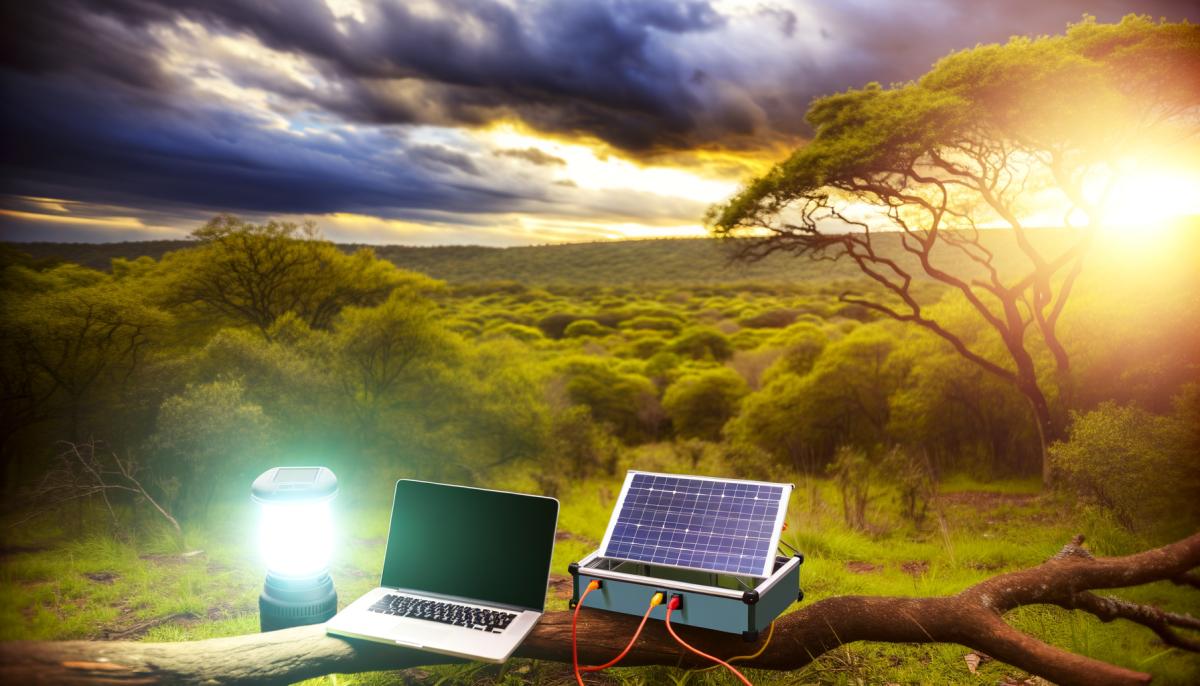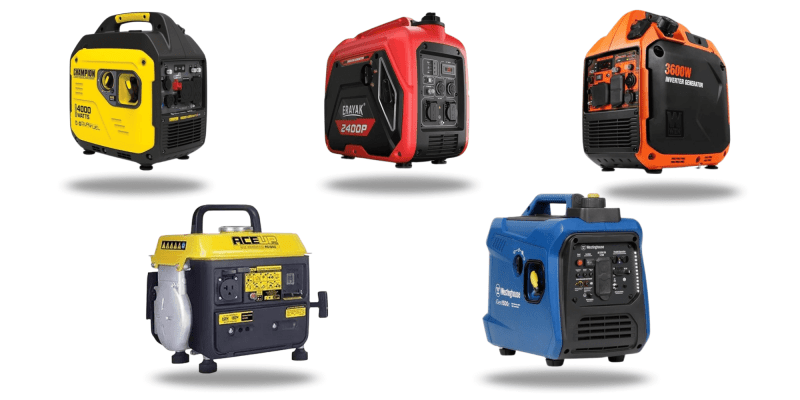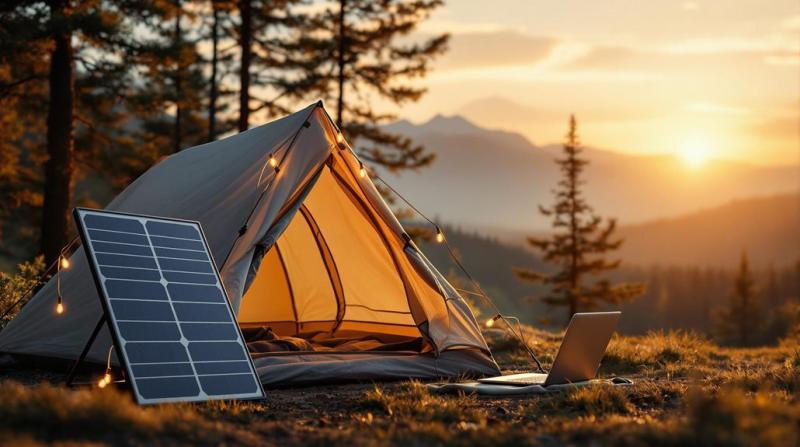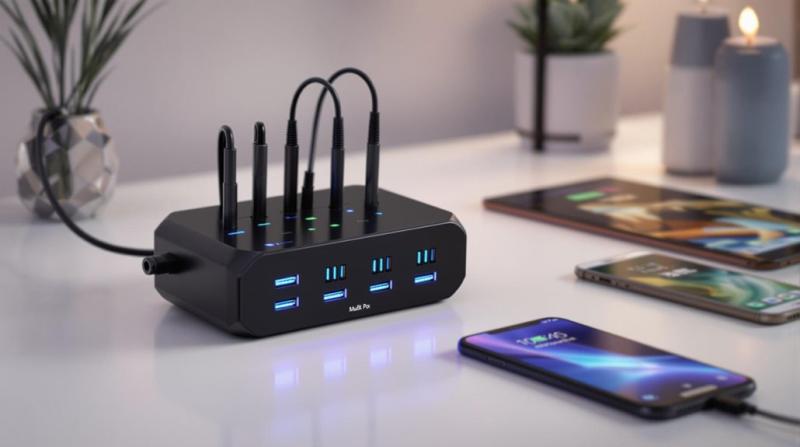When you're on the hunt for long-lasting portable power stations, you can't go wrong with models like the Jackery Explorer 1500 or the Goal Zero Yeti 3000. These babies pack a punch with impressive capacities of 1534 Wh and 3032 Wh, respectively.
With their lithium-ion batteries, you get high energy density and longevity. We're talking over 500 charge cycles!
Efficiency? Super important. Look for units with multiple ports and faster charging technologies to get the most out of them.
But hey, keep in mind that higher capacities usually mean bulkier units. They can be a bit of a workout to carry around.
Don't forget, regular maintenance and proper storage can really help extend battery life.
So, dive in and explore further to find the features that best match your needs for top-notch performance.
Key Features of Long-Lasting Power Stations
When you're picking out a long-lasting portable power station, it's super important to think about its battery chemistry, capacity, and efficiency. These key features really make a difference in how well the power station performs and how long it lasts.
First up, battery chemistry. This basically determines how long the battery will last and how it charges. For instance, lithium-ion batteries are usually the go-to because they offer a higher energy density compared to lead-acid batteries. What does that mean? Well, they can store more power without being super heavy. Plus, lithium-ion batteries have a longer cycle life, often exceeding 500 charge cycles. So, if you're planning to use it a lot, lithium-ion is probably your best bet.
Next, let's talk about capacity. This is measured in watt-hours (Wh) and tells you how much energy the power station can store and deliver. Think about what you'll be using it for—like outdoor adventures, emergencies, or just as a daily backup. Higher capacity units let you power multiple devices at once, which is awesome. But keep in mind, more capacity usually means a heavier device, so you might have to compromise a bit on portability.
And then there's efficiency. This is all about how well the power station turns stored energy into usable power while keeping losses to a minimum. You'll want to look for models with higher efficiency ratings because they give you more bang for your buck. Higher efficiency means you get more usable power from the same amount of energy, so you won't need to recharge it as often. That's a big plus for extending the overall life of the power station.
Top High-Capacity Battery Options
So, when you're checking out high-capacity battery options for portable power stations, it's super important to compare battery capacities. This way, you can get a good idea of how long they'll last, even when you're using them with different loads.
And hey, don't forget about how quickly they can charge! Faster charging is a game-changer, especially when you really need it in a pinch.
Battery Capacity Comparison
When it comes to portable power stations, checking out the battery capacities of the top high-capacity options is super important. These capacities, measured in watt-hours (Wh), tell you how long a power station can keep your devices running before it needs a recharge.
Take the Jackery Explorer 1500, for example. It's got a capacity of 1534 Wh, which makes it great for longer trips or powering more demanding gadgets. On the other hand, the Goal Zero Yeti 3000 packs a massive 3032 Wh. This means you can run multiple devices at once for much longer.
So, when you're picking out a power station, think about what you'll be using it for. If you're just powering small electronics, a lower-capacity station might do the trick. But if you're planning extended outdoor adventures or prepping for emergencies, those higher-capacity models are definitely worth considering.
Also, don't forget to check the inverter capacity along with the battery capacity. This will tell you the maximum load you can connect.
In the end, knowing how battery capacity matches up with your power needs is crucial. It'll help you choose a portable power station that meets both your current and future energy demands.
Charging Speed Efficiency
Charging speed efficiency is super important when it comes to how quickly you can juice up your devices with high-capacity portable power stations. So, when you're checking out your options, keep an eye on the wattage output and the types of ports available.
High-capacity models usually come with multiple ports like USB-C, AC, and DC, which means you can charge several devices at the same time. Pretty handy, right?
You definitely want to look for power stations with fast charging tech like Quick Charge or Power Delivery. These features can really cut down on recharge time. Some of these devices even have smart battery management systems that optimize charging speed and protect against overheating. That's a double win because it also extends the battery life.
Oh, and don't forget to look at the input wattage specs. A higher input rating means you can recharge the power station faster. If you're into outdoor adventures, models that are compatible with solar panels can be a game-changer. Just remember, the charging speed will depend on how sunny it is and how efficient your panels are.
Performance metrics like the milliamp-hour (mAh) rating and cycle life give you more insights into the power station's capabilities. These numbers will help you understand how well it maintains its charging speed over time.
In the end, it's all about balancing charging speed efficiency with the overall capacity to pick the perfect high-capacity portable power station for your needs.
Comparison of Battery Technologies
Battery technologies play a crucial role in shaping the efficiency, lifespan, and overall performance of portable power stations. Each technology has its own set of perks and drawbacks that can really affect your experience when using a power station. The most common battery types you'll find in these devices are lithium-ion, lead-acid, and lithium iron phosphate (LiFePO4).
Lithium-ion batteries are pretty much the go-to for modern portable power stations. Why? Because they've a high energy density, they're lightweight, and they offer a relatively long cycle life. We're talking anywhere from 500 to 2000 cycles, depending on the specific model. This kind of longevity makes them perfect for frequent use.
Now, if you're looking at lead-acid batteries, they're cheaper upfront, but there's a catch. They're heavier and not as efficient. Plus, they've a shorter lifespan, usually around 300 to 500 cycles. Their slower discharge rates and lower energy density make them less ideal if you need something portable.
On the other hand, lithium iron phosphate batteries, which are a type of lithium battery, offer some cool benefits. They're known for enhanced safety and thermal stability compared to standard lithium-ion batteries. They often last over 2000 cycles, but they're a bit pricier. This makes them a great option if you care a lot about longevity and safety, especially in tough conditions.
Factors Affecting Battery Life
Several factors influence the lifespan of your portable power station's battery, impacting both its efficiency and longevity. One of the primary determinants is temperature. Batteries perform best within a specific temperature range, typically between 20°C to 25°C (68°F to 77°F). Extreme temperatures, whether hot or cold, can accelerate degradation, reducing your battery's capacity and overall life.
Here's the thing: charge cycles are super important too. Every time you fully charge and discharge the battery, it counts as one cycle. Most batteries, especially those lithium-ion ones, have a limited number of cycles before their capacity starts to tank. So, if you want your battery to last, avoid those deep discharges. Try to keep it charged between 20% and 80% whenever you can.
Now, let's talk about how you use that power. High-drain devices can really stress the battery out, leading to increased wear and tear. If you're always running power-hungry gadgets, you might find your battery's lifespan getting shorter. It's a good idea to balance your load to prevent excessive draw and keep things running smoothly.
Oh, and don't forget about the quality of the battery itself. Premium batteries often come with advanced management systems that make charging and discharging way more efficient, extending their life.
Maintenance Tips for Longevity
Hey there! If you want your portable power station to last as long as possible, there are a few key maintenance strategies you should follow.
First off, make sure to do regular battery checks. This helps you catch any potential issues early on.
Also, proper storage is super important. It can prevent damage when you're not using your power station.
And don't forget to clean the connections every now and then. It'll make everything run more efficiently and keep your power station performing well for longer.
Regular Battery Checks
Taking the time to regularly check your power station's battery health can really go a long way in boosting its lifespan and reliability.
First things first, keep an eye on the battery's state of charge (SoC). You want to keep it in that sweet spot—ideally between 20% and 80%—to avoid putting too much stress on it during charge and discharge cycles.
Next up, have a look at those battery terminals. Corrosion here can mess with the flow of electricity, which isn't great for performance. Give the terminals a gentle clean and swap out any cables that look damaged.
Oh, and don't forget to check if the battery's temperature feels off. Most batteries have a specific temperature range they like to operate in. If it's feeling too hot or too cold, that's a red flag for potential underlying issues that need fixing.
Also, keep an eye out for firmware updates. Manufacturers often release these to improve battery management systems. Just make sure to check your device's manual for any specific recommendations.
Lastly, make it a habit to run routine performance tests to see how your power station handles under load. This proactive step can help you spot potential problems early, so you're not caught off guard when you really need it.
Proper Storage Techniques
Proper storage techniques are crucial for keeping your portable power station in tip-top shape, ensuring it's ready to roll whenever you need it.
First off, store your power station in a cool, dry place. You know, somewhere away from direct sunlight and those crazy temperature extremes. Ideally, you're looking at a sweet spot between 32°F and 77°F (0°C to 25°C).
Now, let's talk batteries. When storing your power station, it's best to keep the battery partially charged, like around 50%. Trust me, overcharging or letting it drain completely can really mess with its lifespan. Make it a habit to check the battery level now and then. If you notice it's dropping quite a bit, go ahead and give it a little recharge. Just don't let it sit there completely drained for too long, okay?
Got removable batteries? If so, take them out and store them separately. Pop them in a temperature-controlled environment. Easy peasy!
Oh, and here's an important tip: don't stack heavy stuff on top of your power station. Seriously, the pressure can mess with the internal components.
And finally, keep your power station in its original case or a similar protective pouch. This will help prevent any physical damage while it's tucked away.
Follow these steps, and your portable power station will stay effective and reliable whenever you need it. Simple as that!
Clean Connections Periodically
Keeping the connections on your portable power station clean is super important for making sure it works perfectly and lasts a long time. Over time, dust, dirt, and moisture can build up on the connectors, causing issues or even damage. To avoid this, set up a routine to check and clean those connections.
First things first, turn off the power station and unplug everything. Grab a soft, dry cloth and gently wipe away any dust and debris. If there's some stubborn grime, dampen the cloth just a bit with isopropyl alcohol, but don't soak it. Stay away from abrasive materials because they can scratch and mess up the connectors.
Now, take a close look for any signs of corrosion, especially on metal connectors. If you see any, use a wire brush or a cleaning solution made for electronics. After you've cleaned everything, make sure the connections are completely dry before plugging anything back in.
Doing this every few months can really make a difference. Regular cleaning and maintenance keep everything running smoothly, so you won't have to worry about unexpected failures when you need your power station the most.
Real-World Usage Scenarios
Exploring real-world usage scenarios for portable power stations reveals just how versatile and effective they can be in various situations. Whether you're out for some outdoor adventure or prepping for emergencies, these devices come in incredibly handy.
For example, when you're camping or hiking, portable power stations can be absolute lifesavers. They can power up your essential electronics like smartphones, GPS devices, and even portable fridges. Just imagine being on a weekend camping trip and having the peace of mind that your portable power station will keep everything charged up throughout your stay. It's a game-changer, right?
Now, let's talk emergencies. Think about those unexpected power outages due to natural disasters. Having a reliable portable power station means you won't be left in the dark, literally. You could use it to power lights, small appliances, and even medical devices. The first thing you should consider here is the power output capacity. You want to make sure it matches your specific needs during an emergency. Trust me, you'll thank yourself later.
And hey, what about road trips or tailgate parties? A portable power station can seriously elevate your experience. You can power up portable speakers, cooking appliances, or even a small TV to watch the game. In this case, portability and weight become huge factors. You want something you can easily transport without sacrificing the power supply. It's all about finding that perfect balance.
Lastly, let's not forget about everyday at-home backups. A portable power station provides an excellent way to keep your devices charged while avoiding any inconvenience during unexpected electrical shortages. It's super practical and, honestly, quite necessary in daily life and those urgent moments. Understanding these usage scenarios really helps you see the value and necessity of having a portable power station around.
Customer Reviews and Ratings
Customer reviews and ratings are like little gold mines of information when it comes to figuring out the performance and reliability of portable power stations. They can really help you make a smart choice about which model is going to work best for you. By digging into these reviews, you can spot patterns of what people love and what they don't, especially when it comes to key features like how long the battery lasts, how quickly it charges, and how durable it is.
So, when you're looking at ratings, don't just glance at the stars. Take a moment to check out the average score across different platforms. If a product consistently gets high marks, that's usually a good sign it's reliable. And hey, don't forget to look at how many people have actually reviewed it. A power station with thousands of reviews is likely to give you a clearer picture than one that only has a few.
Now, let's talk about those comments. They're seriously a treasure trove of info. People often share their experiences in different situations—like during a camping trip or in the middle of a power outage. Keep an eye out for any common complaints about things like performance issues, how easy it's to use, or how responsive the customer service is. These details can really help you figure out if the power station is going to live up to your expectations.
And don't skip over the reviews that talk about how well the power station holds its battery capacity over time. You want something that not only works great out of the box but keeps performing well even after regular use.



